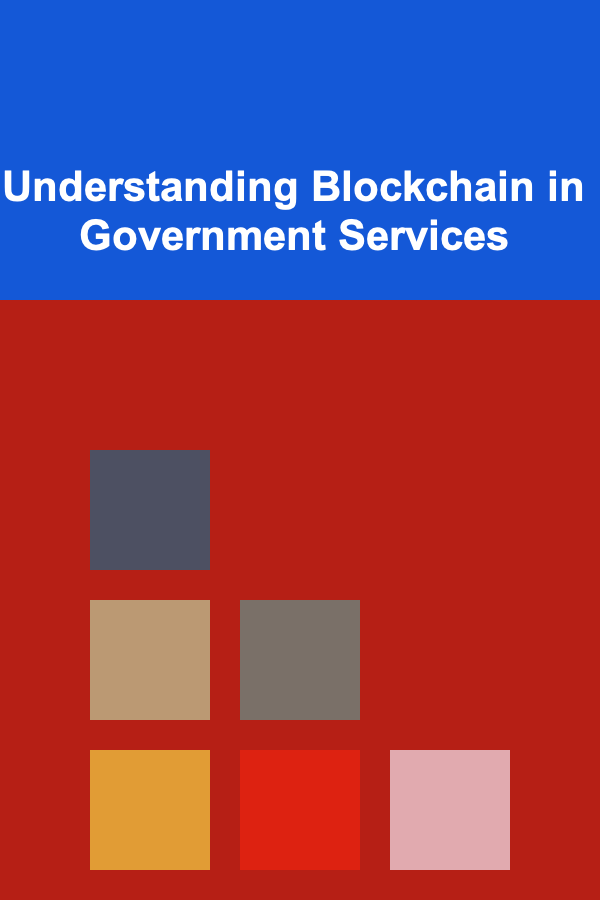
Understanding Blockchain in Government Services
ebook include PDF & Audio bundle (Micro Guide)
$12.99$8.99
Limited Time Offer! Order within the next:

Blockchain technology, initially known for its role in cryptocurrencies like Bitcoin, has transcended its origins to become a subject of intense interest across various sectors, including government. Its potential to enhance transparency, security, and efficiency in public services makes it a compelling area for exploration. This article delves into the intricacies of blockchain technology, its potential applications within government, the challenges associated with its implementation, and the broader implications for governance and citizen engagement.
What is Blockchain? A Foundational Understanding
At its core, a blockchain is a distributed, immutable, and transparent ledger. Let's break down each of these key characteristics:
- Distributed: Unlike traditional databases which are often centralized and managed by a single entity, a blockchain is distributed across a network of computers (nodes). Each node maintains a copy of the entire blockchain, ensuring redundancy and resilience. This distributed nature eliminates the single point of failure risk associated with centralized systems.
- Immutable: Once data is recorded on the blockchain in a block, it cannot be altered or deleted. Each block is cryptographically linked to the previous block, forming a chain. Any attempt to modify a block would require altering all subsequent blocks, which is computationally infeasible due to the cryptographic hashing algorithms used. This immutability provides a strong audit trail and enhances data integrity.
- Transparent: While not always the case (permissioned blockchains offer varying degrees of privacy), many blockchains are transparent, meaning that all participants can view the transactions recorded on the chain. This transparency fosters trust and accountability.
A blockchain operates through a consensus mechanism. This mechanism ensures that all nodes in the network agree on the validity of new transactions before they are added to the blockchain. Common consensus mechanisms include Proof-of-Work (PoW), used by Bitcoin, and Proof-of-Stake (PoS), which is becoming increasingly prevalent due to its energy efficiency.
How it Works: A Simplified Explanation
- A transaction is initiated (e.g., a citizen applies for a government benefit).
- The transaction is grouped with other transactions into a block.
- The block is broadcast to the network of nodes.
- Nodes validate the transaction using the consensus mechanism (e.g., verifying digital signatures and sufficient funds/eligibility).
- Once validated, the block is added to the blockchain, forming a permanent record.
Potential Applications of Blockchain in Government
The characteristics of blockchain make it particularly well-suited for a variety of government applications. Its potential to improve efficiency, transparency, and security is significant.
1. Identity Management
Secure and verifiable identity management is a fundamental challenge for governments. Blockchain can provide a robust platform for digital identities, allowing citizens to securely manage their personal information and access government services.
Benefits:
- Reduced Identity Theft: Blockchain's immutability and cryptographic security make it difficult to forge or tamper with digital identities.
- Simplified Access to Services: Citizens can use their blockchain-based digital identity to securely access various government services, eliminating the need for multiple usernames and passwords.
- Enhanced Privacy: Blockchain can be designed to allow citizens to control which information they share with government agencies, enhancing privacy and data protection.
- Interoperability: A blockchain-based identity system can facilitate interoperability between different government agencies and even across national borders.
Example: Estonia's e-Residency program uses blockchain technology to provide secure digital identities to individuals and businesses around the world, enabling them to access Estonian government services and conduct business within the EU.
2. Supply Chain Management
Governments often manage complex supply chains, from procuring goods and services to tracking the distribution of aid. Blockchain can provide a transparent and auditable record of the entire supply chain, reducing fraud and improving efficiency.
Benefits:
- Increased Transparency: All participants in the supply chain can view the status of goods and materials at any point in time.
- Reduced Fraud: Tamper-proof records make it difficult to introduce counterfeit or substandard goods into the supply chain.
- Improved Traceability: Blockchain allows for easy tracking of goods from origin to destination, enabling quick identification of problems and efficient recalls.
- Enhanced Efficiency: Streamlined processes and reduced paperwork can lead to significant cost savings.
Example: Tracking the distribution of medical supplies during a pandemic. Blockchain can ensure that supplies reach the intended recipients and prevent diversion or theft.
3. Land Registry
Land registries are often plagued by inaccuracies, fraud, and inefficient processes. Blockchain can provide a secure and transparent platform for recording land ownership and transferring property rights.
Benefits:
- Reduced Land Disputes: Immutability and transparency make it difficult to challenge land ownership records.
- Simplified Transactions: Blockchain can streamline the process of buying and selling land, reducing paperwork and transaction costs.
- Increased Transparency: Publicly accessible land records can help prevent corruption and promote economic development.
- Improved Efficiency: Faster and more efficient land registration processes can benefit both citizens and the government.
Example: Georgia is using blockchain technology to secure its land registry and reduce corruption.
4. Voting Systems
Electronic voting systems have the potential to improve accessibility and reduce fraud, but they also raise concerns about security and transparency. Blockchain can provide a secure and auditable platform for online voting.
Benefits:
- Increased Security: Cryptographic security protects against vote tampering and ensures the integrity of the election results.
- Enhanced Transparency: Voters can verify that their votes have been recorded correctly without revealing their individual choices.
- Improved Accessibility: Online voting can make it easier for citizens to participate in elections, especially those who are disabled or live in remote areas.
- Reduced Fraud: Blockchain can help prevent voter fraud by ensuring that each voter can only cast one vote.
Challenges: While promising, blockchain-based voting systems face challenges related to user education, accessibility for all demographics, and the need for rigorous security audits.
5. Smart Contracts
Smart contracts are self-executing contracts written in code and stored on the blockchain. They can automate processes, enforce agreements, and reduce the need for intermediaries. In government, smart contracts can be used for a variety of applications.
Benefits:
- Automated Processes: Smart contracts can automate repetitive tasks, freeing up government employees to focus on more complex issues.
- Reduced Costs: By eliminating the need for intermediaries, smart contracts can reduce transaction costs.
- Increased Transparency: The terms of the contract are publicly visible, ensuring transparency and accountability.
- Improved Compliance: Smart contracts can automatically enforce regulations and ensure compliance.
Example: Automating the disbursement of government benefits. A smart contract could automatically release funds to eligible recipients once certain conditions are met.
6. Record Keeping and Data Management
Governments generate and manage vast amounts of data. Blockchain can provide a secure and auditable platform for storing and managing government records, ensuring data integrity and accessibility.
Benefits:
- Enhanced Data Integrity: Immutability ensures that government records cannot be altered or deleted.
- Improved Data Accessibility: Authorized users can easily access government records from anywhere in the world.
- Reduced Storage Costs: Distributed storage can reduce the need for expensive centralized data centers.
- Simplified Auditing: The transparent and auditable nature of blockchain makes it easier to track changes to government records.
Example: Storing and managing birth certificates, marriage licenses, and other vital records on a blockchain. This can ensure the integrity and accessibility of these records for future generations.
Challenges and Considerations for Implementation
While the potential benefits of blockchain in government are significant, there are also a number of challenges and considerations that must be addressed before it can be widely adopted.
1. Scalability
Many blockchain networks have limited transaction throughput, which can be a bottleneck for government applications that require high transaction volumes. This is particularly true for public blockchains. Solutions like layer-2 scaling solutions (e.g., payment channels, sidechains) and more efficient consensus mechanisms (e.g., Proof-of-Stake) are being developed to address this issue. Governments must carefully evaluate the scalability of different blockchain platforms before deploying them.
2. Security
While blockchain is generally considered to be secure, it is not immune to attacks. Smart contracts, in particular, can be vulnerable to bugs and exploits. Furthermore, the security of a blockchain depends on the security of the underlying infrastructure and the consensus mechanism. Governments must implement robust security measures to protect their blockchain deployments from cyberattacks. Regular security audits and penetration testing are essential.
3. Privacy
The transparency of some blockchains can pose a challenge for government applications that require privacy. While privacy-enhancing technologies (PETs) like zero-knowledge proofs and homomorphic encryption can be used to protect sensitive data, these technologies are still relatively new and complex. Governments must carefully consider the privacy implications of using blockchain and implement appropriate measures to protect citizen data. Consideration should be given to permissioned blockchains, which offer more control over data access.
4. Regulatory Uncertainty
The regulatory landscape for blockchain is still evolving. In many jurisdictions, there is a lack of clarity about the legal status of blockchain-based applications and the responsibilities of blockchain participants. This regulatory uncertainty can create barriers to adoption. Governments need to work with stakeholders to develop clear and consistent regulatory frameworks for blockchain technology. It's important to distinguish between regulating the technology versus regulating the applications built on the technology.
5. Interoperability
Different blockchain platforms use different protocols and data formats, which can make it difficult for them to interoperate. This lack of interoperability can limit the potential benefits of blockchain in government. Efforts are underway to develop interoperability standards, but more work is needed. Government agencies must consider interoperability when selecting blockchain platforms and designing their applications.
6. Skill Gap
There is a shortage of skilled blockchain developers and professionals. This skill gap can make it difficult for governments to implement and maintain blockchain-based applications. Governments need to invest in training and education to develop the necessary skills within their workforce. This could involve partnerships with universities, private sector companies, and online learning platforms.
7. Governance
Effective governance is essential for the success of any blockchain deployment. Governments need to establish clear governance structures and processes to manage their blockchain networks and ensure that they are aligned with their policy objectives. This includes defining roles and responsibilities, establishing dispute resolution mechanisms, and developing mechanisms for upgrading the blockchain. This also entails deciding between public, private, or consortium (hybrid) blockchains, each with distinct governance implications.
8. Legacy Systems Integration
Many government agencies rely on legacy systems that are not easily integrated with blockchain technology. Integrating blockchain with these systems can be complex and expensive. Governments need to carefully plan their integration strategies and invest in the necessary infrastructure and expertise. Often, a phased approach is recommended, starting with smaller pilot projects before attempting full-scale integration.
9. Cost
Implementing and maintaining blockchain-based applications can be expensive. Governments need to carefully evaluate the costs and benefits of blockchain before investing in it. This includes considering the costs of hardware, software, development, maintenance, and training. Open-source blockchain platforms can help reduce costs, but may require more in-house expertise.
10. Public Perception and Trust
Public trust is essential for the successful adoption of blockchain in government. Governments need to educate the public about the benefits of blockchain and address any concerns they may have. Transparency and accountability are crucial for building public trust. This includes communicating clearly about how blockchain is being used, how citizen data is being protected, and how decisions are being made.
The Path Forward: A Strategic Approach
To successfully leverage blockchain technology in government, a strategic and phased approach is crucial.
1. Pilot Projects and Proof of Concepts
Starting with small-scale pilot projects and proof-of-concepts (POCs) allows governments to experiment with blockchain technology, learn from their experiences, and assess its suitability for different applications. This approach minimizes risk and allows for iterative development. Focus on areas where blockchain can deliver clear and measurable benefits, such as streamlining a specific process or improving data integrity.
2. Collaboration and Partnerships
Collaboration with other government agencies, private sector companies, and research institutions can help governments to share knowledge, resources, and best practices. Partnerships can also help to accelerate the development and deployment of blockchain-based applications. This also fosters innovation and reduces the burden on individual agencies.
3. Open Standards and Interoperability
Adopting open standards and promoting interoperability between different blockchain platforms is essential for creating a seamless and interconnected ecosystem. This will enable government agencies to share data and collaborate more effectively. Active participation in industry standards bodies can influence the direction of these standards.
4. Skills Development and Training
Investing in skills development and training is crucial for building a workforce that is capable of implementing and maintaining blockchain-based applications. This includes providing training to government employees, supporting blockchain education programs at universities, and partnering with private sector companies to offer apprenticeships. A focus on cybersecurity skills is also paramount.
5. Public Education and Engagement
Educating the public about the benefits of blockchain and addressing any concerns they may have is essential for building trust and promoting adoption. This includes providing clear and accessible information about how blockchain is being used, how citizen data is being protected, and how decisions are being made. Community forums and public consultations can help to gather feedback and address concerns.
6. Regulatory Clarity and Frameworks
Working towards clear and consistent regulatory frameworks for blockchain technology is essential for creating a stable and predictable environment for innovation. This includes clarifying the legal status of blockchain-based applications, defining the responsibilities of blockchain participants, and developing consumer protection measures. A balanced approach that encourages innovation while protecting consumers is crucial.
7. Ethical Considerations and Responsible Use
Addressing the ethical considerations surrounding blockchain technology is crucial for ensuring its responsible use. This includes considering issues such as data privacy, algorithmic bias, and the potential for unintended consequences. Developing ethical guidelines and frameworks can help to ensure that blockchain is used in a way that is consistent with societal values.
Conclusion: Blockchain as a Transformative Tool for Government
Blockchain technology holds immense potential to transform government services by enhancing transparency, security, and efficiency. While challenges related to scalability, security, privacy, and regulatory uncertainty exist, a strategic and phased approach can help governments overcome these hurdles and unlock the full potential of blockchain. By focusing on pilot projects, collaboration, open standards, skills development, public education, and ethical considerations, governments can leverage blockchain as a transformative tool to improve citizen engagement, enhance service delivery, and build a more transparent and accountable society.
The journey towards widespread adoption of blockchain in government is a marathon, not a sprint. Continuous learning, adaptation, and collaboration will be key to realizing the full potential of this technology to create a more efficient, secure, and citizen-centric government.

How to Design a Beautiful Nursery Without Overspending
Read More
How to Implement a YouTube Video SEO Strategy to Drive Organic Traffic to Your Dropshipping Store
Read More
How to Review and Adjust Your House Expenses Excel Sheet Regularly
Read More
How to Set Up a Smooth Moving Process for Your Home
Read More
Prioritizing Goals Over Tasks: A Deep Dive
Read More
Creating Compelling VR Documentaries: A Comprehensive Guide
Read MoreOther Products

How to Design a Beautiful Nursery Without Overspending
Read More
How to Implement a YouTube Video SEO Strategy to Drive Organic Traffic to Your Dropshipping Store
Read More
How to Review and Adjust Your House Expenses Excel Sheet Regularly
Read More
How to Set Up a Smooth Moving Process for Your Home
Read More
Prioritizing Goals Over Tasks: A Deep Dive
Read More